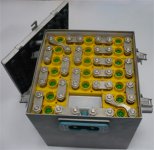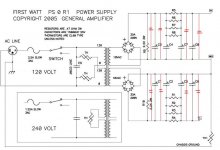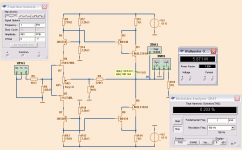gaborbela,
Well, there´s nothing wrong with selling fakes as long as correct information is given. You feel obviously confident so...I do not want to protect MCM electronics.
I think he was referring to the "Le Classe A".... 😉I don't understand, 😕 the "Le monstre" IS running class A, or at least that's what I thought.
Best regards
Ebbe
I don't understand, 😕 the "Le monstre" IS running class A, or at least that's what I thought.
Best regards
Ebbe
Ebbe - "Le Monstre" and "Le Class A" are two amps desgined by Jean Hiraga they are both operating in class A
Carlos - I agree - the bias is quite important in these amps i have heard / measured similar if you dont use enough bias *or* if you go too far with it.
-Dan
3k instead 2.3 will be ok.
12V and 1.2A in monster is less then 24V and 2.6A in F5. So RCR filter resistors will not be so hot. you can use some 0.47 ohm or 1ohm i think. 1k is too much.
50k and CD out - will work fine even without buffer.
12V and 1.2A in monster is less then 24V and 2.6A in F5. So RCR filter resistors will not be so hot. you can use some 0.47 ohm or 1ohm i think. 1k is too much.
50k and CD out - will work fine even without buffer.
I would like to post my shunt that I put in the power supply of my monster.

Nothing spectacular actually.
I have such a module in both the positive supply and in the negative supply.
I have tested it with a capacitor across the sensing resistor: this was never stable, even with 220 muF. It is not needed.
It is also stable without a capacitor across the unit. On the board however I have 2.200 muF and in the PS I have a large capacitor, 25.000 with low ESR.
I have this 'hidden' from the amplifier modules with 0,68 ohm, that have 2x68.000. And I have 1 ohm to the raw input capacitors that have 1x68.000 muF.
The winding delivers 14,2 V AC at 3 Amps, and 14.8 at no load. It is a bifilar wound Métalimphy model (french).
Together this combo will allow the shunt to take 300 mA when cold, and 100 mA when the Le Monstre is at a stable temperature and operating point.
On the scope I see that small changes in the line that always exist do not affect the power, and the residue of the rectification (spikes) is also gone.
I needed the shunt to ensure I have less than 13.5 volts across my 100.000 muF 'super capa's' that I put across my final capacitor bank (even though 14.5 volts is admissible for them).
I have heard that the amplifier sounds smoother and the bandwidth is extended with clarity in the highs. (My Quad electrostat has an impedance of around 1-2 ohms at 20 kHz it is said ... so I obviously need quite some power there, to be supplied by the PS.)
albert

Nothing spectacular actually.
I have such a module in both the positive supply and in the negative supply.
I have tested it with a capacitor across the sensing resistor: this was never stable, even with 220 muF. It is not needed.
It is also stable without a capacitor across the unit. On the board however I have 2.200 muF and in the PS I have a large capacitor, 25.000 with low ESR.
I have this 'hidden' from the amplifier modules with 0,68 ohm, that have 2x68.000. And I have 1 ohm to the raw input capacitors that have 1x68.000 muF.
The winding delivers 14,2 V AC at 3 Amps, and 14.8 at no load. It is a bifilar wound Métalimphy model (french).
Together this combo will allow the shunt to take 300 mA when cold, and 100 mA when the Le Monstre is at a stable temperature and operating point.
On the scope I see that small changes in the line that always exist do not affect the power, and the residue of the rectification (spikes) is also gone.
I needed the shunt to ensure I have less than 13.5 volts across my 100.000 muF 'super capa's' that I put across my final capacitor bank (even though 14.5 volts is admissible for them).
I have heard that the amplifier sounds smoother and the bandwidth is extended with clarity in the highs. (My Quad electrostat has an impedance of around 1-2 ohms at 20 kHz it is said ... so I obviously need quite some power there, to be supplied by the PS.)
albert
hi al thanks for posting the pic of your shunt reg, how do you find the performance of the tl431
-Dan
-Dan
Well Dan,
it's a bit hard to get it out of oscillations zones at times, specifically with the complex circuitry around it (a fast darlington that can dump 8 amperes) but if one stays away from the published 'instability zone', it is ok.
In fact I have also made a TL431/EL84 shunt and a TL431 clock series power supply that really perform well.
I think it should improve the Le Classe A circuit too.
Some don't like the 'noise' of zeners that the TL431 exhibits to a little extent too, well, with such large capacitors around, we have enough inherent noise floors already. It does not get worse on the scope. On my B&K RMS voltmeter the total stays below the 1 mv mark.
albert
it's a bit hard to get it out of oscillations zones at times, specifically with the complex circuitry around it (a fast darlington that can dump 8 amperes) but if one stays away from the published 'instability zone', it is ok.
In fact I have also made a TL431/EL84 shunt and a TL431 clock series power supply that really perform well.
I think it should improve the Le Classe A circuit too.
Some don't like the 'noise' of zeners that the TL431 exhibits to a little extent too, well, with such large capacitors around, we have enough inherent noise floors already. It does not get worse on the scope. On my B&K RMS voltmeter the total stays below the 1 mv mark.
albert
I also used a regulated supply for both le monstres i have built, i had good results with the lm338k
main reason was to kill any hum and keep a stable rail voltage.
-Dan
main reason was to kill any hum and keep a stable rail voltage.
-Dan
Hi dan,
I have also done this for a Kaneda amplifier. It is very hard to get the last glitches from the rectifier out, and the Kaneda is unforgiving.
For the Monstre a supply that works in a softer mode, a regulator that itself - you might say - is class A, works charms. That is the basis for my thinking. However, I have much more capacitance banks than you have, so the topology is quite different.
I used the LM338K like the data sheet suggests: with a 'solid tantal' capacitor at the output (professional solid tantal is not the drop-like form but a tubular form of a casing). This makes the regulator more relaxed than a series of 10.000 muF caps after the regulator.
albert
I have also done this for a Kaneda amplifier. It is very hard to get the last glitches from the rectifier out, and the Kaneda is unforgiving.
For the Monstre a supply that works in a softer mode, a regulator that itself - you might say - is class A, works charms. That is the basis for my thinking. However, I have much more capacitance banks than you have, so the topology is quite different.
I used the LM338K like the data sheet suggests: with a 'solid tantal' capacitor at the output (professional solid tantal is not the drop-like form but a tubular form of a casing). This makes the regulator more relaxed than a series of 10.000 muF caps after the regulator.
albert
Thats an interesting take on it albert, I lean to large capacitance over regulation if i can. I still have not tried a battery monstre.... one day...🙂
-Dan
-Dan
In a local dump-shop they used to have 24 V airplane batteries, before I made up my mind they were sold out. It should be an easy venue with a compact (and safe) form.

As you can see here, it allows attaching a mass connection halfway the cells easily. This picture is for a real tangible aircraft, a larger 40 Ah type but small 8 Ah exist, that are good for continuous connection to the powersupply.
and how about this: a model aircraft battery of 2.800 mAh, why wouldn't that work? 11.1 V nominal would probably allow attaching to 12.5 volts power rails . . . For the money it's worth the try.
albert

As you can see here, it allows attaching a mass connection halfway the cells easily. This picture is for a real tangible aircraft, a larger 40 Ah type but small 8 Ah exist, that are good for continuous connection to the powersupply.
and how about this: a model aircraft battery of 2.800 mAh, why wouldn't that work? 11.1 V nominal would probably allow attaching to 12.5 volts power rails . . . For the money it's worth the try.
albert
Hello all,
I stumbled upon this thread whilst looking for Class A DIY amps. I have no technical knowledge, can recognise components and read a simple circuit diagram and turn that into a finished project. Have made a Gainclone and some years ago a monophonic synthesiser.
I would like to ask a couple of questions;
Will the amp work 4 Ohm 85 db Mark Audio CHP-70 speakers, I'm making a pair of Frugel Horn Mk3's.
And would I need a pre-amp, I use a CD player and Cassette Player.
Regards - Jim
I stumbled upon this thread whilst looking for Class A DIY amps. I have no technical knowledge, can recognise components and read a simple circuit diagram and turn that into a finished project. Have made a Gainclone and some years ago a monophonic synthesiser.
I would like to ask a couple of questions;
Will the amp work 4 Ohm 85 db Mark Audio CHP-70 speakers, I'm making a pair of Frugel Horn Mk3's.
And would I need a pre-amp, I use a CD player and Cassette Player.
Regards - Jim
Hello Jim
85db is very low for these amplifier even in mid sized room.
You need min 88-90db to enjoy the music with these amp.
Yes you can drive direct with CD player these amp, I advise you take a look at the Hiraga Class A amplifier with your speakers! That has min.20W power.
I had 87db and I had sometimes problem to drive my speakers! Specially if you like classical music.
Greetings Gabor
85db is very low for these amplifier even in mid sized room.
You need min 88-90db to enjoy the music with these amp.
Yes you can drive direct with CD player these amp, I advise you take a look at the Hiraga Class A amplifier with your speakers! That has min.20W power.
I had 87db and I had sometimes problem to drive my speakers! Specially if you like classical music.
Greetings Gabor
Dear Gabor,
Thanks for your reply I;m pleased that it doesn't need a preamp.
I went to Toppsy's house to listen to the FH Mk3's he'd made, one pair with Fostex and the other with the MA CHP-70, I thought the MA speakers were much better than the Fostex ones. The amplifier in use was an 8 watt 300b and drove the speakers with no problem at all and with all sorts of music. The FH3's are single driver horns and presumably an easy load for an amplifier, though of course I am probably wrong about that 🙂
I thought the Hiraga amp was the solid state version of the 300b and thats why I am keen to make one. I will have to find the circuit for the 20 watt Hiraga.
The CHP-70's are 18 watt, 4 ohm, 85 db 4" units
Regards - Jim
Thanks for your reply I;m pleased that it doesn't need a preamp.
I went to Toppsy's house to listen to the FH Mk3's he'd made, one pair with Fostex and the other with the MA CHP-70, I thought the MA speakers were much better than the Fostex ones. The amplifier in use was an 8 watt 300b and drove the speakers with no problem at all and with all sorts of music. The FH3's are single driver horns and presumably an easy load for an amplifier, though of course I am probably wrong about that 🙂
I thought the Hiraga amp was the solid state version of the 300b and thats why I am keen to make one. I will have to find the circuit for the 20 watt Hiraga.
The CHP-70's are 18 watt, 4 ohm, 85 db 4" units
Regards - Jim
Hello
Be aware many Fostex drivers are over 90db, some of them are very loud!
When you use 4PC 85db drivers that would be higher than 85db, that no longer 85db. Probably you can match the Le Monstre with your speaker.
I tried with 87db it was OK. But for every day use it would be better 89-90db speaker!
Greetings Gabor
Be aware many Fostex drivers are over 90db, some of them are very loud!
When you use 4PC 85db drivers that would be higher than 85db, that no longer 85db. Probably you can match the Le Monstre with your speaker.
I tried with 87db it was OK. But for every day use it would be better 89-90db speaker!
Greetings Gabor
Le monstre with 4 Ohm speakers impedance
Hello ALL.
i would like to realize the Le Monstre amplifier with battery psu.
Anyone knows the output impedance of this amplifier?
Connecting it to a 4 Ohm impedance speakers, may i suppose to have more then 14 watts of power?
Can this amp drive 4 ohm impedance speakers?
Thanks to all and regards from Italy.
Maurizio.
Hello ALL.
i would like to realize the Le Monstre amplifier with battery psu.
Anyone knows the output impedance of this amplifier?
Connecting it to a 4 Ohm impedance speakers, may i suppose to have more then 14 watts of power?
Can this amp drive 4 ohm impedance speakers?
Thanks to all and regards from Italy.
Maurizio.
Hi Maurizio, see my post #713, where I mentioned some measurements.
Output = 2,45 volt RMS, Without a load.
Output = 2,05 V RMS, with a 8 ohms load.
Impedance is about 0,75 ohms (the 0,3 amp gives a 0,4 v drop..)
(I didn't measure 4 ohms). At 4 ohms the max output therefore is not 14 watts.
The Monstre works well in the range of 4 to 20 ohms.
The amplifier can drive 4 ohms but this must be a higher efficiency one to get you above 100 db in your room ...
albert
Output = 2,45 volt RMS, Without a load.
Output = 2,05 V RMS, with a 8 ohms load.
Impedance is about 0,75 ohms (the 0,3 amp gives a 0,4 v drop..)
(I didn't measure 4 ohms). At 4 ohms the max output therefore is not 14 watts.
The Monstre works well in the range of 4 to 20 ohms.
The amplifier can drive 4 ohms but this must be a higher efficiency one to get you above 100 db in your room ...
albert
I have setup my Le Monstre for spice test.
I use common transistors and MJL3281 MJL1302 for output.
3 changes:
- Potentiometer 50 Ohm to increase current in JFETs
- R1 and R12 = 270 Ohm for 0.8A bias in output
Some results:
THD 0.100% = 3 Watt in 8 Ohm
THD 0.203% = 5.87 Watt
Le Monstre works best at 0.8A bias.
Nothing to gain by increase.
I use common transistors and MJL3281 MJL1302 for output.
3 changes:
- Potentiometer 50 Ohm to increase current in JFETs
- R1 and R12 = 270 Ohm for 0.8A bias in output
Some results:
THD 0.100% = 3 Watt in 8 Ohm
THD 0.203% = 5.87 Watt
Le Monstre works best at 0.8A bias.
Nothing to gain by increase.
Attachments
- Home
- Amplifiers
- Solid State
- Hiraga "Le Monstre"


